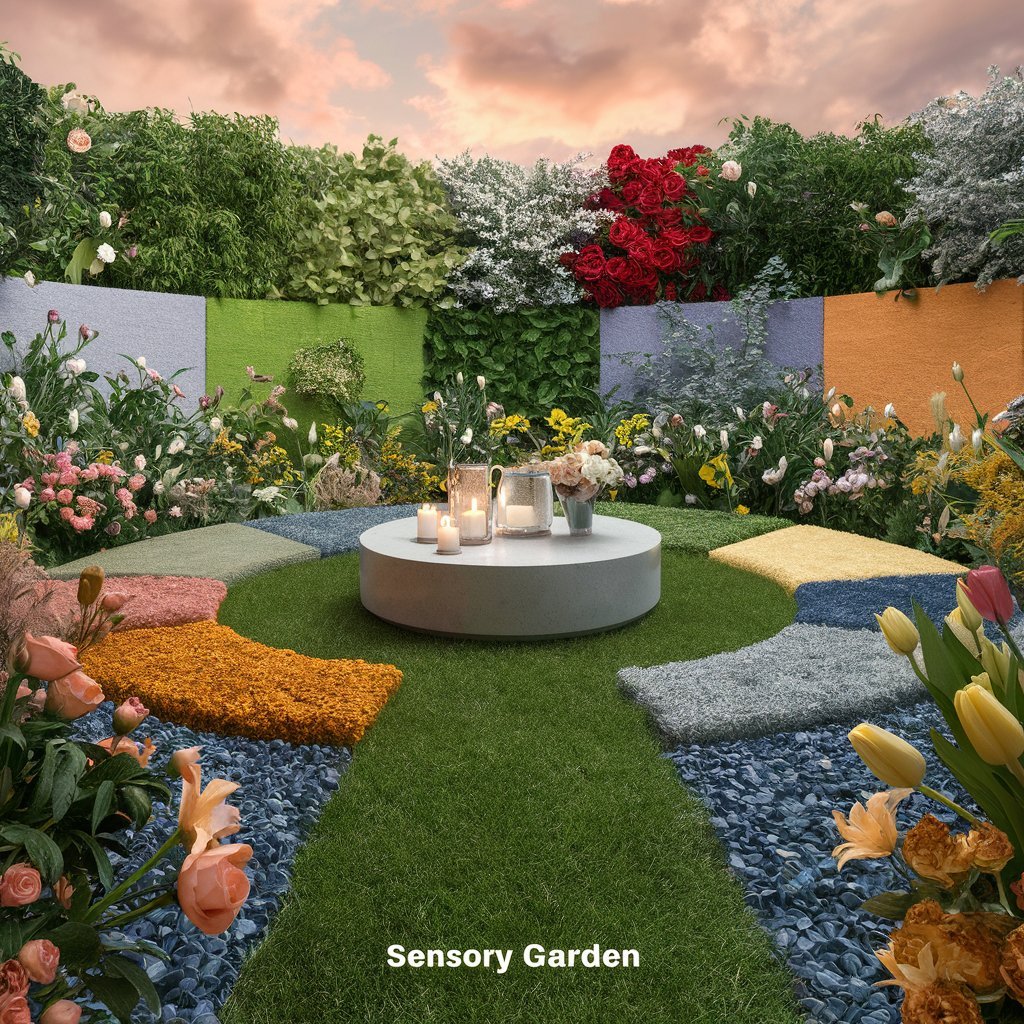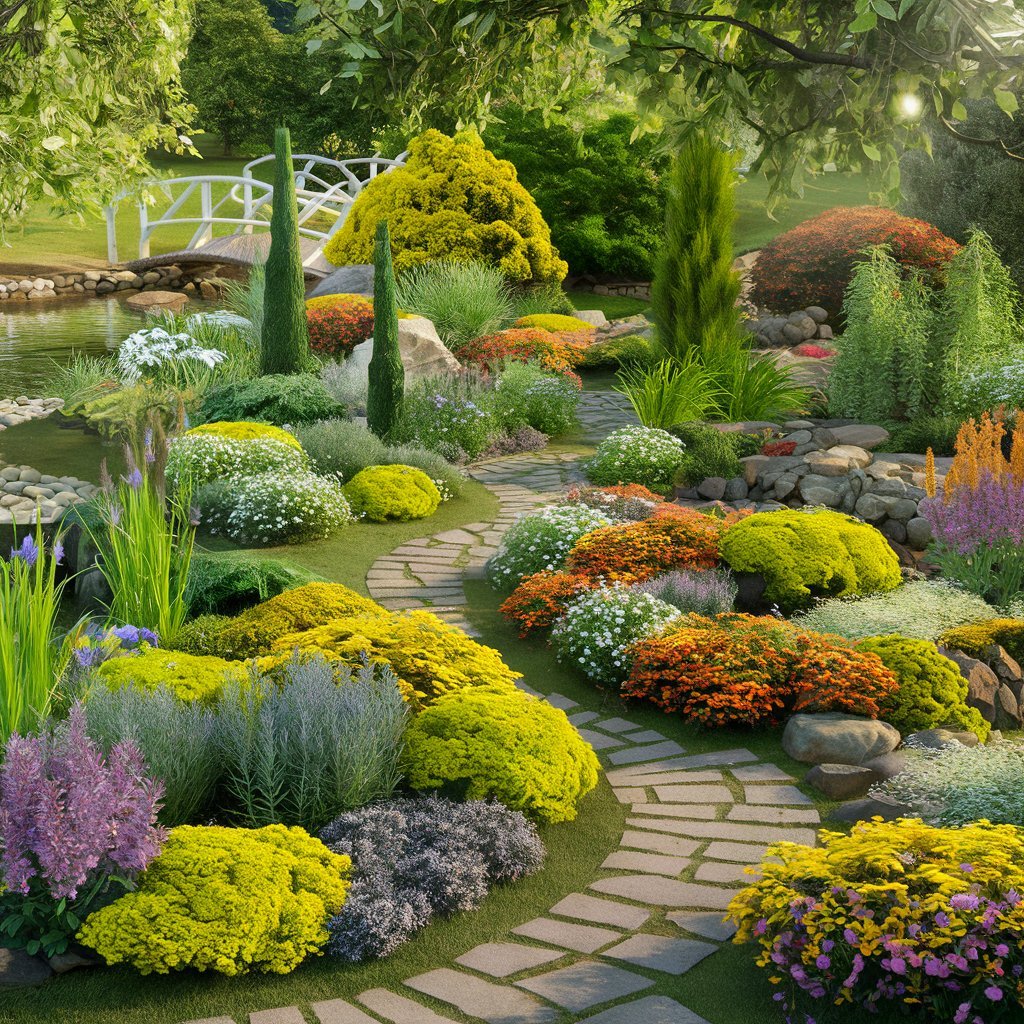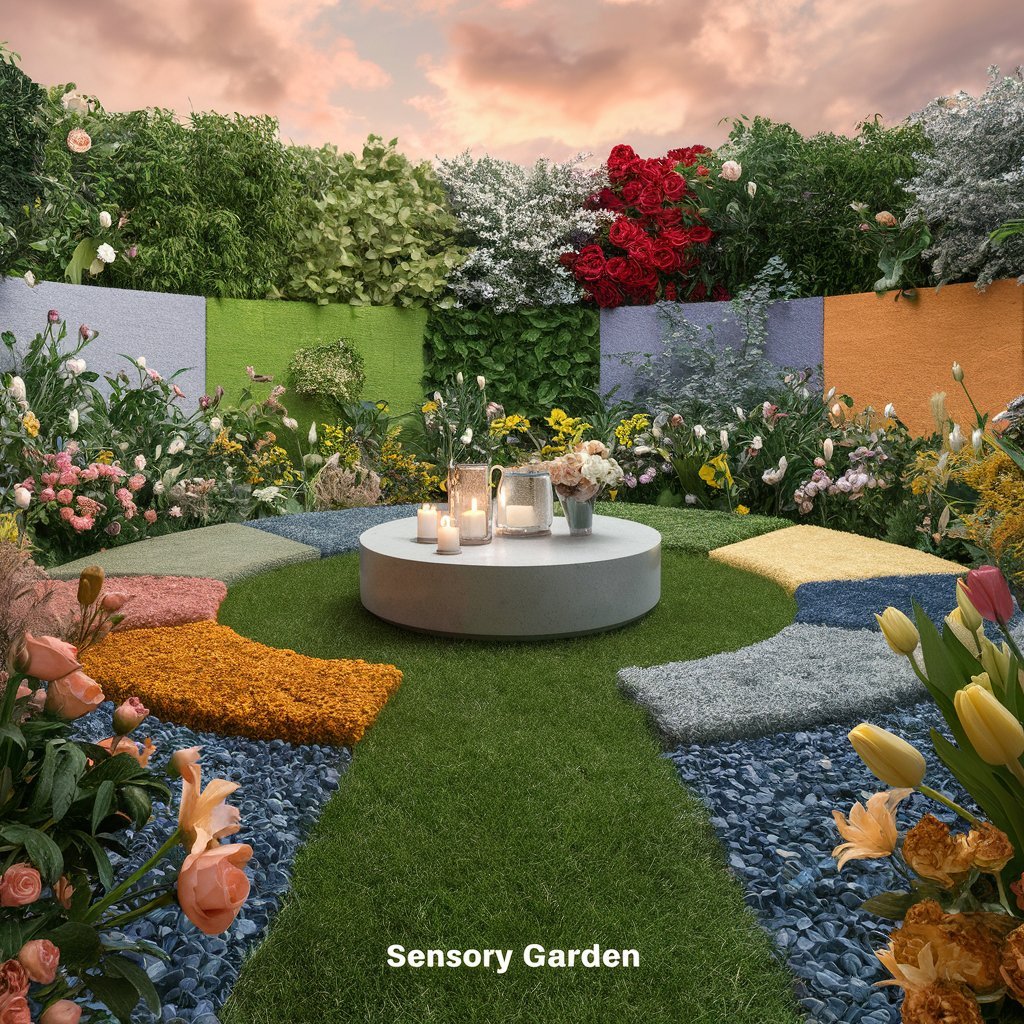Creating a Sensory Garden
A sensory garden is a space that tickles all five senses, offering a therapeutic and enriching experience. Perfect for anyone looking to boost their mental well-being through nature.
Engaging All Five Senses
Sensory gardens are designed to stimulate the senses in fun and delightful ways. By mixing hard elements like benches with soft ones like flowers, a sensory garden offers an immersive experience.
- Sight: Use contrasting colors, shapes, movement, light, and shadow to create a visual feast. Think about adding gazing balls, mirrors, and sculptures (Penn State Extension).
- Touch: Include plants with different textures, like fuzzy leaves, smooth bark, and spiky stems. This encourages hands-on exploration.
- Sound: Add wind chimes, rustling grasses, and water features to create a soothing soundscape.
- Smell: Plant aromatic species like lavender, roses, honeysuckle, and jasmine to fill the air with delightful scents (Homes & Gardens).
- Taste: Grow edible plants such as herbs, fruits, and vegetables. This lets visitors engage their taste buds in a natural and enjoyable way.

Benefits for Various Groups
Sensory gardens offer loads of benefits for different folks, making them a versatile addition to any space.
- Kids: Sensory gardens spark curiosity, creativity, and a sense of adventure. They provide safe spaces for exploration and independence (Lawn Love).
- Seniors: These gardens offer physical activity, access to sunlight, and a sense of purpose. Scents can trigger pleasant memories, creating a joyful space for older adults.
- Individuals with Disabilities: Sensory gardens can be a haven for those with disabilities, like Autism Spectrum Disorder (ASD). They provide a calming environment that stimulates the senses and encourages social interaction (Lawn Love).
- Mental Health Conscious Individuals: For those dealing with stress, anxiety, or mild depression, sensory gardens offer a natural way to improve mental well-being. The multi-sensory experience can be both calming and revitalizing.
- Gardening Enthusiasts: Both beginners and experienced gardeners can find purpose in creating a sensory garden. It adds a therapeutic aspect to their hobby, enhancing overall enjoyment.
- Urban Dwellers: City residents looking to connect with nature can create green sanctuaries in limited spaces. Sensory gardens provide a peaceful retreat from the urban hustle.
- Mindfulness Practitioners: Individuals interested in expanding their mindfulness practice can benefit from the meditative aspects of a sensory garden. It offers a serene setting for nature-based meditation techniques.
- Busy Professionals: Those seeking stress-relief methods that don’t require extensive time commitments can find solace in a sensory garden. It provides a peaceful environment to unwind and recharge.
Creating a sensory garden can transform any space into a therapeutic oasis, benefiting a wide range of individuals. For more ideas on how to design your own sensory garden, check out our articles on peaceful garden ideas and healing garden design.
Designing a Therapeutic Oasis
Creating a sensory garden that serves as a therapeutic oasis involves careful planning and thoughtful design. Let’s explore how to pick plants that stimulate the senses and add elements for a full sensory experience.
Picking Plants for Sensory Fun
Choosing the right plants is key to a successful sensory garden design. The goal is to engage all five senses: sight, smell, sound, touch, and taste. Here are some plant ideas for each sense:
Sight
To make the garden visually appealing, use plants with different colors, shapes, and movements. Accessories like gazing balls, mirrors, and sculptures can also add to the visual effect (Penn State Extension).
- Colorful Flowers: Marigold, tulips, and sunflowers
- Varied Forms: Ferns, ornamental grasses, and topiary shrubs
- Movement: Bamboo, ornamental grasses, and wind chimes
Smell
Add plants with both subtle and strong fragrances to create an immersive smell experience.
- Sweet Smells: Peony, hyacinth bulbs, and roses
- Herbs: Lavender, rosemary, and mint
- Unique Scents: Sweet shrub, pine needles, and nasturtium (Penn State Extension)
Sound
Sound can be introduced through plants that rustle in the wind and by adding water features or wind chimes.
- Rustling Plants: Bamboo, quaking aspen, and silver grass
- Water Features: Fountains and small waterfalls
- Wind Chimes: Metal, bamboo, or glass chimes
Touch
Select plants with a variety of textures to encourage tactile exploration.
- Soft: Lambs’ ear, moss, and lamb’s ear
- Fuzzy: Yarrow and sage
- Rough: Tree bark and prickly seed pods (Penn State Extension)
Taste
Edible plants can provide a delightful taste experience.
- Fruits: Strawberries, blueberries, and raspberries
- Herbs: Basil, thyme, and mint
- Vegetables: Cherry tomatoes, snap peas, and bell peppers
Elements for a Full Sensory Experience
Besides plant selection, adding various elements can enhance the overall sensory experience of the garden.
Visual Elements
- Mirrors and Gazing Balls: Reflect light and create intriguing visual effects.
- Sculptures: Add artistic flair and focal points.
- Lighting: Use solar lights or LED fixtures to highlight pathways and features.
Auditory Elements
- Water Features: The soothing sound of water can enhance relaxation.
- Wind Chimes: Create gentle melodies with metal, bamboo, or glass chimes.
- Bird Feeders: Attract birds and enjoy their natural songs.
Tactile Elements
- Textured Pathways: Use materials like gravel, mulch, or smooth stones.
- Interactive Features: Install a sandpit or a touch-and-feel wall with various textures.
Olfactory Elements
- Aromatic Plants: Place fragrant plants near seating areas or along pathways.
- Herb Garden: Create a dedicated section for aromatic herbs.
Gustatory Elements
- Edible Garden: Incorporate raised beds or containers for growing fruits, vegetables, and herbs.
- Tasting Stations: Set up areas where visitors can sample fresh produce or herbs.
By carefully selecting plants and incorporating sensory elements, we can create a therapeutic oasis that engages all five senses. For more ideas on creating a peaceful and mindful garden, check out our articles on peaceful garden ideas and plants for stress relief.

Practical Tips for a Sensory Garden
Making It Accessible and User-Friendly
Designing a sensory garden means making sure everyone can enjoy it. Think about the little things like path widths, surfaces, slopes, access to toilets, and places to sit. By keeping these in mind, we can create a garden that’s fun for everyone, including those with sensory impairments.
Here’s what to keep in mind:
- Path Widths: Make sure paths are wide enough for wheelchairs and walkers.
- Surfaces: Use non-slip, smooth surfaces to avoid trips and falls.
- Slopes: Keep slopes gentle for easy access.
- Rest Areas: Add plenty of benches and shaded spots.
| Feature | What to Consider |
|---|---|
| Path Widths | At least 36 inches wide |
| Surfaces | Non-slip, smooth |
| Slopes | Gentle inclines |
| Rest Areas | Benches, shaded spots |
For more ideas on creating a peaceful and accessible garden, check out our peaceful garden ideas page.
Durability and Upkeep
Sensory gardens are all about interaction—touching, smelling, and even picking plants. So, the garden needs to be tough enough to handle all that love. The challenge is to pick plants and materials that can take a bit of roughhousing (Sensory Trust).
Here’s how to keep your garden looking great:
- Tough Plants: Choose plants that can handle a lot of touching.
- Replaceable Plants: Include some plants that are easy to replace.
- Sturdy Materials: Use strong materials for garden features to withstand wear and tear.
| Aspect | Solution |
|---|---|
| Plants | Tough or easily replaceable varieties |
| Materials | Strong, weather-resistant |
| Design | Features that can handle frequent use |
Regular maintenance is key to keeping the garden in top shape. This means routine tasks like weeding, pruning, and replacing damaged plants. For more on the therapeutic benefits of gardening, check out our therapeutic horticulture section.
By focusing on making the garden accessible, user-friendly, and durable, we can create a sensory garden that’s a relaxing haven for everyone. For more tips on designing healing gardens, visit our healing garden design page.
Making Your Garden a Haven
Chill Spots and Shade
Comfort is everything when it comes to a sensory garden. Seating is a game-changer. It makes the garden more welcoming, especially for those who need a break. Think about it: benches, recliners, and hammocks scattered around, inviting you to sit, relax, and soak in the beauty.
| Seating Type | Perks |
|---|---|
| Benches | Solid support, perfect along pathways |
| Recliners | Great for long, lazy rests |
| Hammocks | Fun and super relaxing |
Don’t forget about shelter. A bit of shade or cover from the rain can make your garden usable all year round. Pergolas and fold-out canopies are lifesavers here. They not only protect you from the elements but also create cozy corners for chilling out. Need more tips on creating a peaceful garden? Check out our peaceful garden ideas.
Sensory Fun and Games
A sensory garden should be tough enough to handle all sorts of interactions—touching, picking, smelling, you name it. This means using durable plants and materials. Some plants are practically indestructible, perfect for curious hands (Sensory Trust).
Making a garden truly sensory involves getting creative. Bird feeders, nectar-rich plants, and even interactive art can make a big difference. Imagine birds chirping, bees buzzing, and art pieces you can touch and play with. Adding storage, water points, and electricity for lights and music can take it to the next level (Sensory Trust).
| Sensory Feature | What It Does |
|---|---|
| Bird Feeders | Attract birds, adding sights and sounds |
| Nectar-rich Plants | Bring in pollinators, making the garden lively |
| Interactive Art | Engage multiple senses—touch, sight, and sound |
Designing for all senses means thinking beyond just the basics. Orientation, balance, color, texture, patterns, movement, contrast, sound, smell, taste, and even the overall vibe all play a part in creating a sensory-rich garden. For more on therapeutic gardening, check out our article on therapeutic horticulture.
By weaving these elements together, you can turn a simple garden into a soothing retreat for the mind and soul.

My name is Michelle Warren, and I’m the founder of Peaceful Gardening. As a 10-year breast cancer survivor, I’ve discovered the profound therapeutic power of gardening. This journey has not only helped me recover but has also become my passion and a source of ongoing peace and joy.
Peaceful Gardening was born from my desire to share the healing benefits of gardening with others. Whether you’re facing health challenges, dealing with stress, or simply looking to connect more deeply with nature, this space is for you.
Over the past decade, I’ve cultivated not just plants, but a deep understanding of how gardening can positively impact mental health. I’ve worked with local community gardens, led workshops on mindful gardening practices, and collaborated with mental health professionals to develop gardening-based stress reduction programs.
Peaceful Gardening was born from my desire to share the healing benefits of gardening with others. Whether you’re facing health challenges, dealing with stress, or simply looking to connect more deeply with nature, this space is for you.
Here, you’ll find evidence-based advice on using gardening as a tool for mindfulness, stress relief, and emotional healing. I share personal stories, practical tips, and scientifically-backed information on how to create your own therapeutic garden space, no matter the size of your yard or balcony.
My mission is to help you discover the joy, peace, and healing that comes from nurturing plants and connecting with nature. Join me in exploring how the simple act of tending to a garden can transform your mental and emotional wellbeing.
Welcome to Peaceful Gardening – let’s grow together towards better mental health!”

